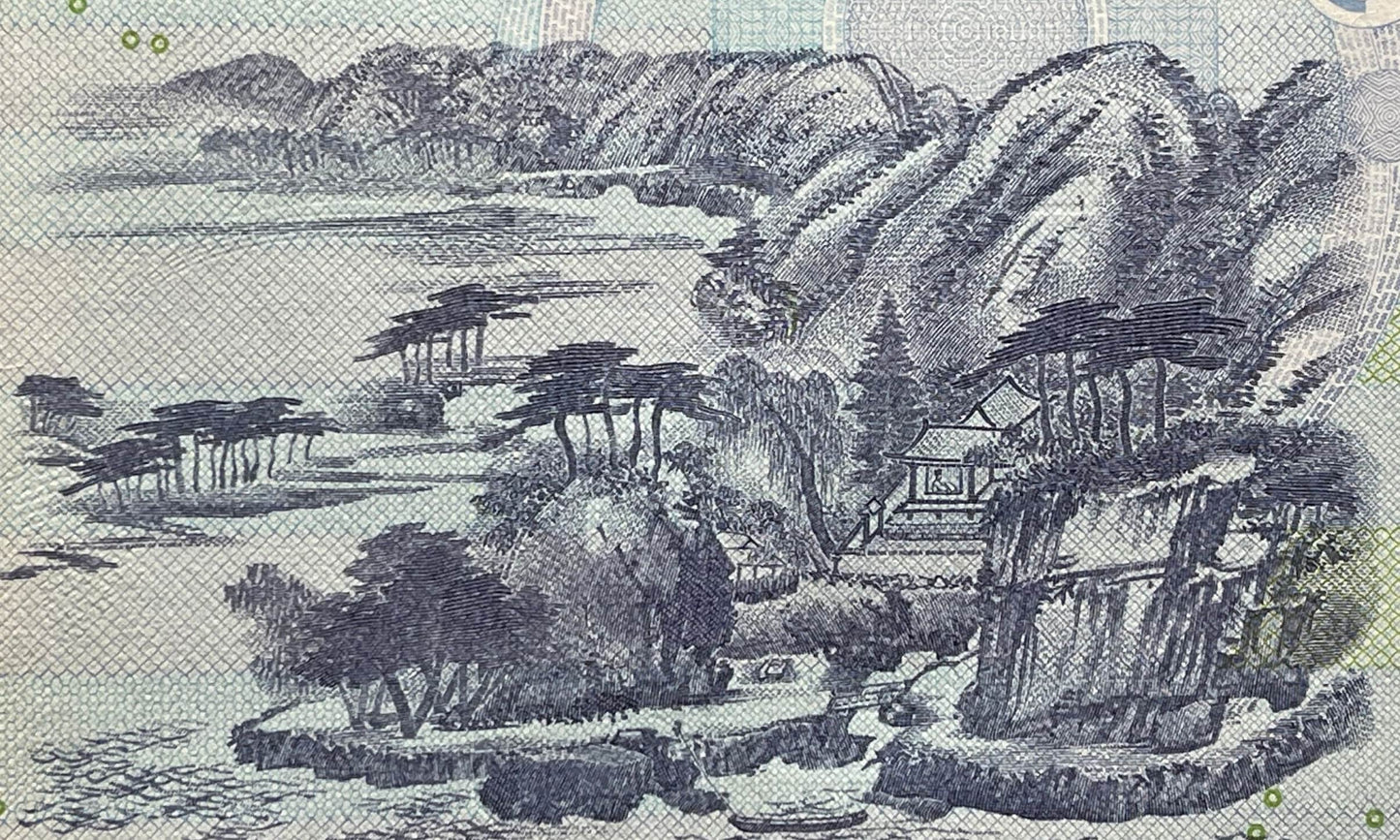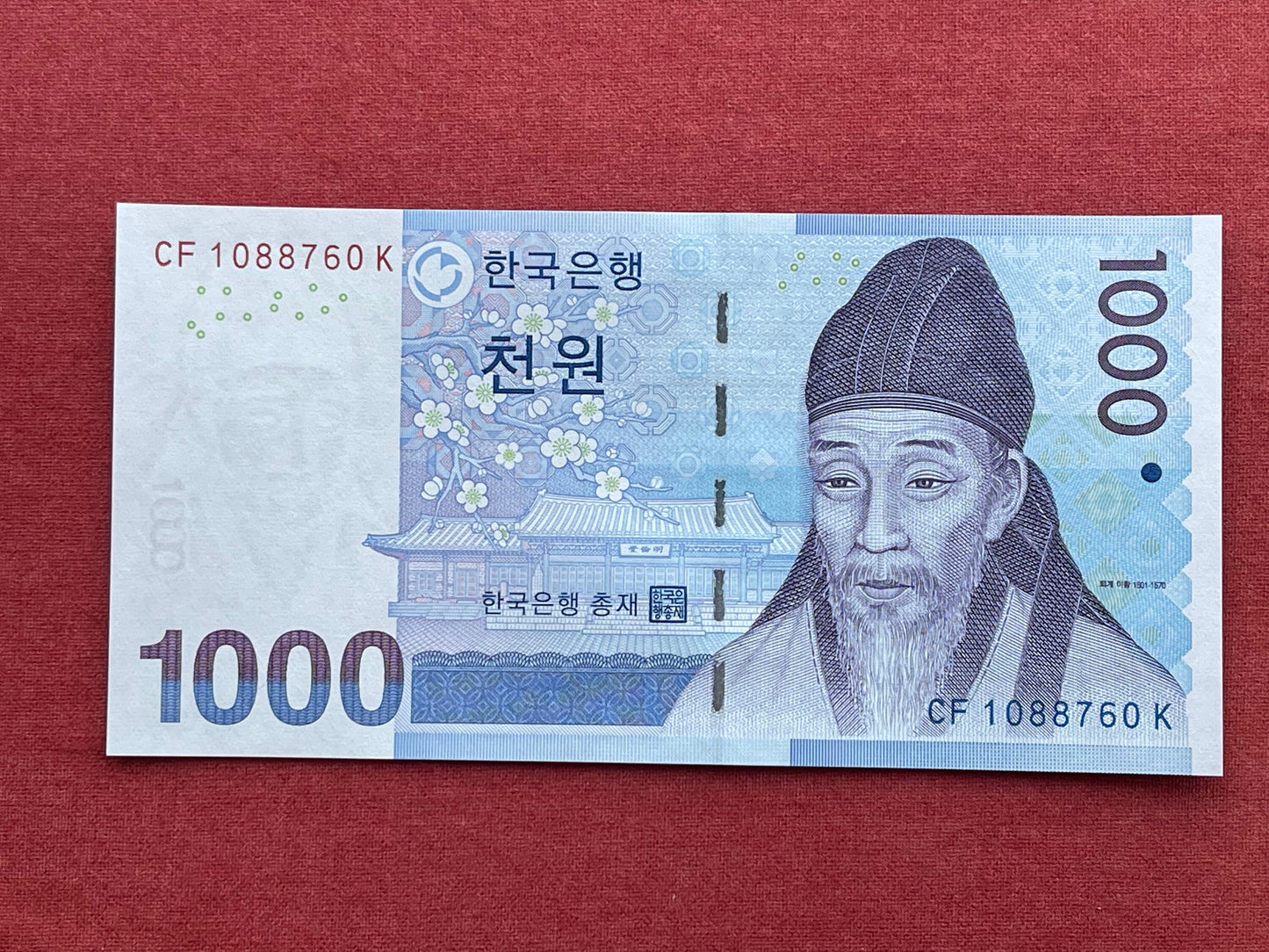elemintalshop
Confucian Sage Yi Hwang & Dosan Seowon Academy 1000 Won Authentic Banknote Money for Jewelry and Collage (2007) Toegye (Green Plum Blossoms)
Confucian Sage Yi Hwang & Dosan Seowon Academy 1000 Won Authentic Banknote Money for Jewelry and Collage (2007) Toegye (Green Plum Blossoms)
Couldn't load pickup availability
Confucian Sage Yi Hwang & Dosan Seowon Academy 1000 Won Authentic Banknote Money for Jewelry and Collage (2007) (Neo-Confucian Philosopher) (Toegye) (Korean Green Plum Blossoms)
Obverse: Portrait of Yi Hwang
Myeongryundang, a lecture hall in Seonggyungwan, a educational institution that was founded during the Joseon Dynasty
Script: Hangul
Lettering:
한국은행
천원
Translation:
Bank of Korea
One Thousand Won
Reverse: The painting "Gyesangjeonggeodo" that illustrates Yi Hwang in the Dosan Seowon Confucian academy.
Blooming flowers of the Korean Green Plum (Plumus mume). In Korea, the plum blossom is a symbol for spring. It is a popular flower motif, amongst other flowers, for Korean embroidery.
Scripts: Hangul, Latin
Lettering: Bank of Korea
1000 Won
1000
Watermark: Yi Hwang and electrotype "1000".
Features
Issuer South Korea
Period Republic (1948-date)
Type Standard banknote
Year 2007
Value 1,000 Won
1000 KRW = USD 0.84
Currency New won (1962-date)
Composition Paper
Size 136 × 68 mm
Shape Rectangular
Number N# 201806
References P# 54
Wikipedia:
Yi Hwang (1501–1570) was a Korean philosopher, writer, and Confucian scholar of the Joseon Dynasty. He was a figure of the Neo-Confucian literati, established the Yeongnam School and set up the Dosan Seowon, a private Confucian academy.
Yi Hwang is often referred to by his pen name Toegye ("Retreating Creek"). His courtesy name was Gyeongho.
Some of his writings were looted by the Japanese military during the Japanese invasion of Korea.
Teachings
Yi Hwang was the author of many books on Confucianism. He followed the dualistic Neo-Confucianism teachings of Chu Hsi, which views i (Chinese "li") and gi (Chinese "qi") as the forces of foundation of the universe. Yi Hwang placed emphasis on the i, the formative element, as the existential force that determines gi. This school of thought contrasted with the school that focused on the concrete element of gi, established by Yi Hwang's counterpart Yi I. Understanding the determinative pattern of i would be more essential in understanding the universe than recognizing the principles that govern individual manifestations of gi. This approach of placing importance on the role of i became the core of the Yeongnam School, where Yi Hwang's legacy was carried on by prominent figures such as Yu Seong-ryong and Kim Seong-il.
Yi Hwang was also talented in calligraphy and poetry, writing a collection of sijo, a three line poetic form popular with the literati of the Joseon period.
Ten Diagrams on Sage Learning
The Neo-Confucian literature of Seonghaksipdo was composed by Yi Hwang in 1568 for King Seonjo. It is a series of lectures for rulers through examples of past sages. Traditional Confucians had affirmed that any man could learn to become a sage; the new Confucians made the ideal of sagehood real and attainable, just as enlightenment was for Buddhists. Yi Hwang intended to present that path by starting each chapter with a diagram and related text drawn from Zhu Xi or another leading authority, and concluding with a brief commentary. He intended for “Ten Diagrams” to be made into a ten paneled standing screen, as well as a short book, so that the mind of the viewer could be constantly engaged with its contents, until it totally assimilated the material.
******
Wikipedia:
Dosan Seowon (alternatively, Tosansowon) was established in 1574 in what is present day Andong, South Korea, in memory of and four years after the death of Korean Confucian scholar Yi Hwang by some of his disciples and other Korean Confucian authorities. Yi Hwang had retired to the location in 1549 and begun construction on the facility, a private Korean Confucian academy offering instruction in the classics and honouring the sages with regular memorial rites.
Like other Korean Confucian academies, Dosan Seowon serves two purposes: education and commemoration. The site was well known in Korea as one of the leading academies and was home to the Toegye School of Thought for over 400 years. Although the educational function of the facility has long since ceased, the commemorative ceremonies have been and are still held twice a year.
The ancient academy was royally chartered in 1575 by King Seonjo and was featured on the reverse of the South Korean 1,000 won bill from 1975 to 2007 (BOK Series Designation Series II (나) 1983–2002).
Share



















